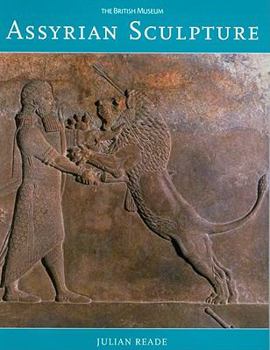Assyrian Sculpture
Select Format
Select Condition 
Book Overview
For almost three centuries, until 612 B.C., the small kingdom of Assyria dominated the Middle East, its empire at one point extending from Iran to Egypt. The story of those years--the triumphs of the... This description may be from another edition of this product.
Format:Paperback
Language:English
ISBN:071412141X
ISBN13:9780714121413
Release Date:September 2012
Publisher:British Museum Press
Length:96 Pages
Weight:0.80 lbs.
Customer Reviews
3 ratings
Skip the first chapter?
Published by Thriftbooks.com User , 15 years ago
I was so pleased with how much I learned about Assyrian art and how interesting it was. I had seen pictures of Assyrian art before, but never knew enough to appreciate it. The text gives background information to help understand the sculptures, etc. Embedded in the text are numbers corresponding to the images on each page--usually two or three, perhaps even four images. Thus, it is easy to actually see what is being discussed in the text. The opening chapter, I suppose, is obligatory--recounting the various French, German, and British excavations. The reader could skip this chapter without suffering any loss the rest of the book . If I could make only one trip to the British museum, I would read this book prior to the visit. As it is, my next trip will be even more interesting, having read the book.
Assyrian art in its finest
Published by Thriftbooks.com User , 17 years ago
Assyrian sculpture is one of the highest points (as is gold jewelry discovered in Nimrod, so called Nimrod Gold) of Assyrian art. Animal depictions especially are vivid, powerful and rather realistic, which is a rare occurence in those times. The Russian writer Ljubimov wrote in his book about ancient art, that if there were only one sculpture of this nation (The wounded Lioness) discovered we would know that the Assyrians had great art and thus the great soul. This book's fime illustrations prove Ljubimov's point. As for depicting the ancient Assyrians as cruel looters, etc, they have not done anything what was not customary during those times and they were not as cruel as the Bible depicts them. The Bible was written by a nation which was conquered by Assyrian, that's why we hear tales of Assyrian cruelty for more than 2500 years already. But writers of the Bible have done the same things to the nations they conquered - khanaan, etc. So stop it already! Can't you just enjoy beautiful art without spilling out your ingrained historical hatred?
"These heavy, earth-bound idols"
Published by Thriftbooks.com User , 20 years ago
Most of the sculpture described in this book is to be found in the British Museum, which indeed is where I purchased Dr. Reade's book. However, "Assyrian Sculpture" should appeal to a broad audience, especially those of us who have been following recent events in Iraq and would like a brief overview of this country's ancient imperial megalomaniacs. Even as we pulled down monuments to Saddam Hussein, so did successive dynasties of Assyrian kings loot the palaces of their predecessors and proclaim their own glory. Visitors to their palaces were forced to view a procession of triumphalist scenes, depicting the king at war, his exploits in the hunting field, and his status as exalted by Assyrian gods and genies. For almost three centuries, until 612 B.C., the small kingdom of Assyria dominated the Middle East, its empire at one point extending from Iran to Egypt. "Assyrian Sculpture" relates the story of those years in sculpted stone, and more rarely in glazed brick, and offers its readers a glimpse of a long-lost civilization.The archaeological discovery, starting in 1843, of a wealth of artifacts from the ancient Assyrian Empire brought to the attention of Europeans a form of artistic production that was unique and unexpectedly striking to many contemporary eyes. Roughly comparable arrays of ancient Assyrian artifacts found by both French and English excavators and transported with great difficulty to Europe, were put on display almost simultaneously in the Louvre and British Museum, starting in 1847. The first archaeologists to explore ancient Assyrian ruins were Paul-Emile Botta, a French diplomat, and Austen Henry Layard, an adventurous English lawyer. In the mid-nineteenth century they both explored mounds in and near present-day Mosul, a city in northern Iraq that embraces the site of ancient Nineveh. Between the two of them, they uncovered the remains of five Assyrian palaces. One, excavated by Layard in Nineveh, was the "palace without rival" of Sennacherib, perhaps the greatest of the Assyrian kings. The inner walls and courtyards were lined with two miles of sculptured stone slabs depicting the king's various campaigns, from the Persian Gulf to the Mediterranean. It was under his rule that a system of canals and aqueducts brought water fifty miles from the Zagros Mountains to the parks, orchards, and gardens of Nineveh.Within the palace Layard discovered thousands of clay cuneiform tablets, constituting the world's earliest-known comprehensive collection of written knowledge. In the chapter, "Biblical History in Assyrian Sculpture" the author states that although there is little direct evidence for the historicity of the biblical accounts that emerged from Layard's excavations, they did confirm that "the early history of Palestine, as recorded in the Bible, was more than a work of fiction."Buy this book for its magnificent reproductions of Assyrian animal sculpture, for its fascinating biography of Austen Henry Layard, and for its c




